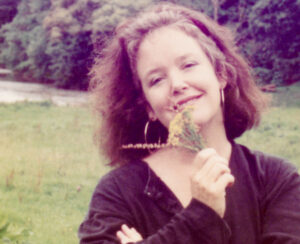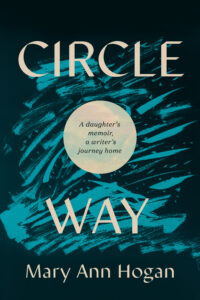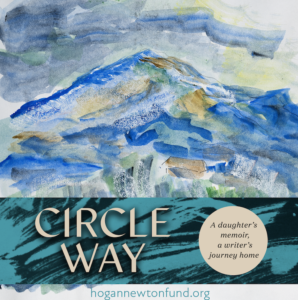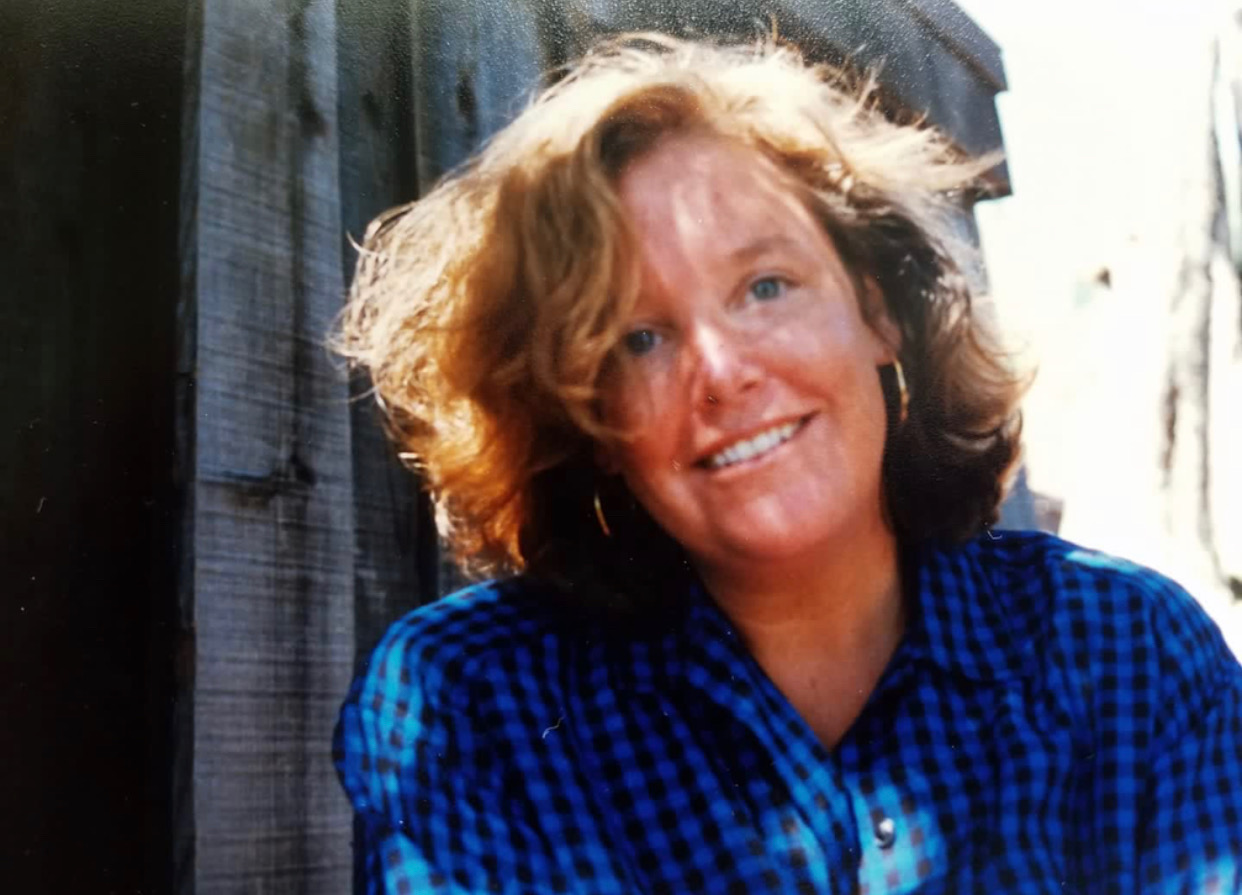Writer and teacher Mary Ann Hogan’s book, Circle Way, hit the bookstores on Valentine’s Day, 2022. Proceeds go to the Hogan-Newton Fund at the Miami Foundation to benefit young journalists.
AWARDS!
Circle Way has won the 2023 Gold Nautilus Award in the national contest’s category for “Lyric Prose.” Nautilus celebrates “Better Books for a Better World,” honoring works that support conscious living, green values, wellness, social change, social justice and spiritual growth. The lyric category focuses on books “evoking compassion, wisdom, greater understanding, empathy, joy, delight, and passion through lyric prose, poetry-prose hybrid, and other genre blending works expressed in poetic language.”
Also this year, the book was a 2023 Montaigne Medal Finalist, an honor for “the most thought-provoking books.” The medal, part of the Eric Hoffer Book Awards, is named after French philosopher Michel de Montaigne, who influenced thinkers such as Shakespeare, Descartes, Emerson, Nietzsche and Hoffer.
In addition, Circle Way won two 2023 Pub West design awards, a Gold Medal in the “Adult Trade Book, Non-Illustrated” category, where the judges said “never before have so many judges ‘oohhed’ and ‘aahhed’ over the clever design…” In addition, the book won a special Silver Medal among all books in the competition. Judges were impressed by “the design care and attention to detail… the printing, the quality of the paper, subtle design choices and the beauty of the overall package — all added up to exceptional.”
The book, selected for the 2023 Bay Area Book Festival, was well received by reviewers.
REVIEWS!
1. ‘Unusual, poetic, evocative’
From “Late Bay Area journalist’s poetic memoir ‘Circle Way’ brings her journalist father’s melancholy into focus,” by Sue Gilmore, Feb. 10, 2022, Bay City News Foundation (used by newsrooms around the Bay Area).
Excerpts:
“In an artful writer’s hands, a memoir can become an acutely intimate unveiling of sorts, a peeling back of time, circumstances and events that manages to zero in on the quintessence of an individual human life.
“The late journalist Mary Ann Hogan’s highly unusual, poetic and evocative ‘Circle Way,’ titled for the beloved Mill Valley home she grew up in and returned to in adulthood, accomplishes that and more. In lyrical, episodic chapters, each bearing keenly resonant titles, murky pictures emerge and then crystallize around not one, but four connected lives. Chief among them is that of her own father, Bill Hogan, a journalist and revered book editor for many years for the San Francisco Chronicle, whose gentle melancholy and feelings of inadequacy she is attempting to understand by poring through six clothbound notebooks of musings, notes, sketches, paintings and letters he left behind.
“As the book’s subtitle, ‘A Daughter’s Memoir, a Writer’s Journey Home,’ indicates, her probings are also an attempt to fathom what lies in her own psyche, her own hesitancies and misgivings, including the things that, she writes, ‘entered my marrow at birth.’ So the memoir from this fourth generation Californian is also a family saga, narrowing in on her great-grandfather Hugh Hogan, a son of Irish immigrants who became a hugely successful lumber tycoon in Oakland before losing it all in the Great Depression.
“Mary Ann … intersperses her own prose in ‘Circle Way’ with excerpts of writings and sketches she discovered in her father’s journals, and her remarkable gifts for language and imagery are immediately apparent on the first page of her ‘Prologue,’ where she describes the wonder of encountering them:
“ ‘Reading the entries, studying the images, feels like prying open a shell to find the unpolished gem inside, an accident of beauty,’ she writes. ‘The result of some poor mollusk’s fury to preserve himself, his haven invaded. A precious thing that began with an intruder, maybe small as a pebble, tiny as a grain of sand, maybe invisible, a mere molecule of pain whose origins run just beyond the tide of knowing.’
“Her father’s persona slowly expresses itself through these excerpts, which are a revelatory delight — alternately mournful, wondering, wry, humorous and oftentimes expressing mild surprise (‘Imagine that!’ being one of his most frequent utterances). His daughter’s fond recollections of their time together amplify the developing picture of a man who was immensely talented but beset with doubt, deeply introspective but unremittingly kind and generous with others. She also probes how his complicated paternal heritage might have shaped both their lives.
“An uncannily effective chapter titled ‘Eye of the Storm’ near the end of the book interweaves an account of a horrific hurricane she lived through with her husband and two sons in South Florida with the story of a huge upheaval in the lives of the Hogans in mid-1920s Oakland — tumults in two time periods, both physical and emotional, that left marks on all their lives. …
“An element that renders this story even more poignant is that Mary Ann, who worked on the book over three decades, died before she could quite complete it. Its scene-setting foreword and its utterly moving final chapter, ‘Afterlife,’ were written by a fellow journalist, her editor, admirer and longtime husband, Eric Newton. Always a partner in the enterprise she considered her life’s work, Newton describes their relationship at the beginning of his concluding chapter: ‘If we need a number, the Hogan-Newton partnership spanned five decades, my entire adult life and most of hers.’
“ ‘I am her editor and she is my writer. Always. As writing partners, we season our stories like salt and pepper. I’m structure and function. She’s music. She’s magic.’ ”
2. A Valentine’s Day story
Excerpts from the San Francisco Chronicle feature story, “Late journalist’s memoir wrestles with legacy of her father, an esteemed Chronicle books editor,” online Feb. 13, 2022, in print for Valentine’s Day.
“Circle Way” is … fittingly, the title of Mary Ann’s posthumously published memoir … which her husband, fellow journalist and media educator Eric Newton, completed during the coronavirus pandemic.
“… Circle Way” is a collage of vignettes drawn from both Mary Ann’s and Bill’s lives, a hybrid of journalism and poetry, father and daughter. It’s also a multigenerational reflection on writing, family and the thorny question of destiny, particularly whether a parent’s unrealized dreams might be passed down to the next generation.
“ ‘Mary Ann wondered, could there be some inherited reason why her father couldn’t do his book, and she couldn’t do her book? She’d say, ‘Was something rolled down the generations to me?’ Newton recalled. … the memoir’s unusual format, consisting of sketches and snippets of memories, was dictated by ‘Mary Ann’s beliefs in the nature of memory itself,’ which is slippery, nonlinear, unwittingly poetic.
“Newton promised Mary Ann in her final days that he would complete her memoir, her ‘unfinished life’s work,’ and see “Circle Way” through to publication.
“He gets choked up reading aloud from the foreword he wrote in August: ‘On February 14, 2019, four months before she died, my wife left a card on my nightstand. It asked, ‘Will you be my Valentine one more time and forever?’
“ ‘The answer is in these pages.’ ”
3. ‘Deeply felt, lyrical’
Excerpts from a book review in the San Francisco Chronicle, by Carolyn West on Feb. 11, 2022, “Daughter’s memoir of her literary father in S.F. brings a remarkable story home.”
“ ‘Circle Way,’ the title of Mary Ann Hogan’s memoir, is a street in Mill Valley. It’s the physical center in this deeply felt, lyrical family story, a starting place and destination for Mary Ann’s story. Around this center swirl the pieces of a California saga that reaches back to the 19th century. It travels from Ireland to California, then Florida and back to California. The story is of triumph and loss, hurricanes and homecomings.
“At the heart of the story is William Hogan, Mary Ann’s father. He was the renowned literary editor for The Chronicle during the middle 20th century when California was re-creating American literature. Bill Hogan was a brilliant, gentle, incomplete man, whose work as literary editor made him a friend to luminaries like John Steinbeck, Jack Kerouac, M. F. K. Fisher and more. Yet, for much of his life, Bill Hogan was stymied when it came to his own art. Something held him back from creating literature.
“To Mary Ann, the lack was an absence in her father’s being. She set out to discover the forces that shaped the Hogan family, both father and daughter.
“ ‘Circle Way’ gives us selections from Bill Hogan’s paintings and private journals, created after his retirement from The Chronicle. The subject matter and composition of the paintings have the feel of midcentury modern art. But the color palette and line energy evoke William Blake. Bill Hogan’s words are prose poems, a form not recognized in his time. They have the precision of some of George Oppen’s ‘Notebook’ pieces and the scope of Robert Hass’ wide-ranging prose poems.
“The memoir is a collaboration, an endeavor to discover and hold the swirl of love and influence of family.
“… (its) loving conclusion takes us full circle to what we were promised in the epigraph. The words are Kurt Vonnegut’s but written in Bill Hogan’s hand: ‘We are here to help each other get through this thing — whatever it is.’ ”
4. ‘The Best Present’
Review by Sunny Solomon, The Pioneer
Excerpts:
“ … Many long-time readers may remember Bill Hogan, the San Francisco Chronicle’s book editor. And ‘Circle Way’ is not only the title of Mary Ann Hogan’s memoir, it’s also the name of the street in Mill Valley where the home she loved and grew up in is located.
“As successful and highly regarded as Bill Hogan was, he never published a book of his own. ‘Circle Way’ is the author’s attempt to uncover the reasons why her dad didn’t consider himself a real writer. …
“… I need to note that ‘Circle Way’ is not a story of parental abuse or an unhappy childhood. It is, however, a spectacular story of an immensely fascinating family, replete with business magnates, others fallen into poverty and even a long-held secret: a black sheep whose time in San Quentin came to be a lynchpin for his success and a window through which the author could see her family more clearly.
“… Not a memoir about death or grief, ‘Circle Way’ is about life and living. Wrap a bow around your pre-ordered copy of “Circle Way.’ It will be the best holiday present you can give or receive.”
About the reviewer: Sunny Solomon is a freelance writer and head of the Clayton Book Club in the East Bay region of Northern California’s San Francisco Bay Area. Visit her website.
5. ‘Tender and Lyrical’
“ ‘To what degree does family mean destiny?’ Mary Ann Hogan asks. A fourth-generation Californian, she followed in her father Bill’s footsteps as a local journalist. Blending his work with her own prose, ‘Circle Way’ is a delicate, searching memoir.
“ … Collage-like, the book is rich in song lyrics and wordplay as well as family anecdotes. It reaches back to reflect on a Catholic upbringing; zeroes in on Hogan’s son’s time in the ICU at birth and preparation for a Florida hurricane; and comes full circle as Hogan returns to California and becomes a weekly columnist for a small newspaper.
“ … Tender and lyrical, Circle Way is a multilayered story of family and fate that focuses on a father-daughter pair of writers.
6. ‘A Book to Watch For’
In its end-of-the-year book column, the San Francisco Chronicle listed nine titles coming out in early 2022 as promising “to be great” from writers who should be “universally admired.”
One of the nine recommended books was Mary Ann Hogan’s Circle Way.
Here’s what the newspaper said:
Circle Way: A Daughter’s Memoir, a Writer’s Journey Home
By Mary Ann Hogan
(Wonderwell; 232 pages; $29)
“In this visually rich, lyrical book, the late Mary Ann Hogan reflects on a life of letters and her relationship to her late father, Bill Hogan, well-known literary editor at The Chronicle. “Circle Way” is a bittersweet memoir of a father, daughter and a prominent California family. At the heart of the story, journalist Mary Ann grapples with identity, family, terminal illness and the creative calling. Sifting through her father’s notebooks after his death, Mary Ann discovers a man whose unrealized dreams echo her own. This is a moving exploration of literature, family and history illustrated with Bill Hogan’s original sketches and watercolors.”
UPDATES
Three ways to support the nonprofit Hogan-Newton Fund for Young Journalists
We believe young journalists are the answer to America’s local news crisis. You can support the fund by buying Circle Way, giving a direct donation and (coming soon) buying digital art from the book.
Endorsements for Mary Ann’s book, Circle Way
From the publisher, Wonderwell:
—–
CIRCLE WAY
A Daughter’s Memoir, a Writer’s Journey Home
By Mary Ann Hogan
“I will spend the rest of my life trying to fully know, to fully understand, and fully appreciate who my father was.”
—–
Bill Hogan was known by millions of newspaper readers as an esteemed literary critic, a journalist and writer once described by John Steinbeck as “an old and valued friend.” Yet within her father’s private journals, Mary Ann Hogan finds a man of both success and regret, a man whose unrealized dreams echoed her own.
In a haunting, lyrical memoir, CIRCLE WAY: A DAUGHTER’S MEMOIR, A WRITER’S JOURNEY HOME (Wonderwell; February 2022), the author and fourth generation Californian explores her father’s complex relationship with the generations that came before — uncovering, along the way, an eclectic and fascinating cast of characters whose roots extend deep into the Golden State. From her lumber baron great-grandfather to the great-uncle whose murky past involved a stint in San Quentin, from her father’s contributions to the literary world to her own journalistic pursuits, Hogan paints a vivid picture of a remarkable family—those who escaped the prisons of their own making, and those who didn’t.
Using what her father left behind—notebooks, drawings, paintings, and letters from the literary elite — Hogan lovingly pieces together the scattered fragments of her history. Part memoir, part poetry, part love letter, part family saga, CIRCLE WAY is Mary Ann Hogan’s search for her father’s story—and the discovery of her own.
The author’s share of proceeds from CIRCLE WAY will be donated to the Hogan-Newton Fund for Young Journalists at the Miami Foundation.
About the author: The late Mary Ann Hogan was an award-winning journalist and teacher whose credits included The New York Times, The Washington Post, the San Francisco Chronicle, the Oakland Tribune, and Mother Jones. She specialized in personal essays, and for six years was syndicated by the Los Angeles Times. She lectured nationally on writing through the American Press Institute and the Poynter Institute for Media Studies, and was a newsroom writing coach at the South Florida Sun Sentinel and for the Freedom Forum’s Chips Quinn Scholars Program for Diversity in Journalism. She taught writing at San Francisco State University, Palm Beach State College, and at Florida Atlantic University, where she earned a Master of Fine Arts in creative nonfiction. Returning to her childhood home in Mill Valley before she died in 2019 of lymphoma, she wrote a community column for the Marin Independent Journal.
About the author of the foreword and final chapter: Eric Newton is writer and consultant. He was an award-winning newspaper editor in Northern California who became managing editor of the content team that created the original Newseum in Rosslyn, Virginia. As a vice president at the John S. and James L. Knight Foundation, he developed hundreds of millions of dollars in journalism grants. As Innovation Chief for the Walter Cronkite School of Journalism and Mass Communication at Arizona State University, he advanced the “teaching hospital model” of journalism education.
About the publisher: Wonderwell is an award-winning hybrid publisher of trade nonfiction books that help, heal, and inspire. The company is headquartered in Los Angeles, CA. Visit us at: wonderwell.press / Follow us at: @wonderwellpress
More praise for CIRCLE WAY:
“One can’t help comparing Mary Ann Hogan to Joan Didion. The prose is subtle; the insights, piercing. CIRCLE WAY…speaks eloquently to what goes unsaid in any family.” — Susan Stern, director, Bad Attitude: The Art of Spain Rodriguez
“A love letter not only to the author’s literary father, but also to the vanished lives and sensibilities of an earlier California…it’s a bittersweet pleasure to share her journey.” — Sarah Pollock, writer and editor
“CIRCLE WAY is a gorgeous and refreshing exploration of writing and family. Hogan’s masterfully woven memoir offers new ways to consider the stories of our lives — what appear to be gaps in knowledge are ultimately paths to understanding.” — Kate Schmitt, author of Singing Bones
CIRCLE WAY: A DAUGHTER’S MEMOIR, A WRITER’S JOURNEY HOME / Mary Ann Hogan / Wonderwell / 2-15-22 | $29.00 | Hardcover| ISBN: 9781637560129
OBITUARY
Here is the author’s obituary, largely written in advance by her and published upon her death:
 Mary Ann Hogan,
Mary Ann Hogan,
1951-2019
Here is the author’s obituary, largely written in advance by her and published upon her death:
Mary Ann Hogan, longtime journalist and beloved writing teacher, crossed over Thursday, June 13, 2019 in the Mill Valley home she cherished, after a year-long tango with a rare form of lymphoma. Her husband, her two sons, and her dog were with her. Mary Ann saw death not as an ending, but rather as the beginning of the final, infinite chamber in the nautilus shell of a creative life.
Mary Ann did not follow the rules. She followed her creative instinct, enthusiastically pushing the boundaries of teaching, writing, cooking, singing, gardening, living – whatever she took on. She raised a family and made friends with the same artistic passion.
After graduating from the University of California at Santa Cruz, Mary Ann started writing freelance for the Washington Post and the San Jose Mercury News. She then became an award-winning staff writer for Bob and Nancy Maynard’s Oakland Tribune.
“Mary Ann made me a better editor,” recalled Sarah Pollock, who was Hogan’s editor at the Tribune and a longtime journalism professor at Mills College. “She taught me to listen with imagination and heart.”
“Mary Ann would arrive at my desk trailing a ten-foot-tail of dot-matrix printer paper filled with anecdotes and descriptions and questions and wonderful leaps of imagination,” she said. “We learned together how to collaborate … and the stories she created were beautiful. Many went viral, as we would now call it, reprinted in newspapers all over the country.”
Mary Ann left daily journalism to raise her two sons, William and James. She began to teach, both at San Francisco State University and in private writing groups. She continued to freelance, her stories appearing in most of the nation’s major newspapers. For six years, she wrote personal essays that were nationally syndicated by the Los Angeles Times.
Her stories explored the human condition, with headlines such as: “Why We Harp and Carp” or “Twigged Out: the Nesting Instinct.”
One day, Mary Ann got a message at an old email address from a nun asking “Are you the author who wrote this story about ‘Why We Cry’ ? If so, can you please send me a new copy? I have been Xeroxing this one for 10 years for my workshops for homeless women and can no longer read the type.” Mary Ann sent the story – and then flew to Southern California to lead one of the nun’s workshops.
In 1994, she followed her husband, digital news futurist Eric Newton, to Virginia. There, she took on a new challenge as the primary writer for the history exhibits at the original Newseum in Arlington, Va. The news museum’s popular history gallery was conceived, written and edited using her “Whole Story” writing method.
In Virginia, she also began a 15-year tenure as a writing coach with the Chips Quinn Scholars program, training hundreds of young journalists of color, many of whom went on to stellar careers.
“Mary Ann was a gift and my guide. She made me shine,” said Tonya Alanez, who covers crime and breaking news at the South Florida Sun Sentinel, where she was part of the team that won the 2019 Pulitzer Prize for Public Service.
From the time she was an intern, Alanez was coached by Hogan, first through the Chips Quinn and later when Mary Ann was the Sun Sentinel’s writing coach.
“She taught me to connect the dots rather than line them up,” Alanez said, “to strike a chord, an emotional chord … to write with heart.”
When the family moved to Florida, Mary Ann took her coaching to the national stage, training thousands of professionals from hundreds of publications via the American Press Institute, Poynter Institute, Maynard Institute and many other organizations, including the John S. and James L. Knight Foundation. At Poynter, her online class, “News Sense,” was one of the most popular self-directed courses for a decade.
Hogan was born in San Francisco on Sept. 1, 1951 into a newspaper family. Her father, William Hogan, a Stars and Stripes correspondent during World War II, spent more than 40 years as literary and drama critic for the San Francisco Chronicle, 27 of them as book editor. Her mother, Phyllis, joined the Chronicle during the war as the chief “copy boy” in the newsroom, later becoming a writer and teacher.
Like her parents, Mary Ann met her future spouse in a newsroom. In 1979, she was a feature writer at the Oakland Tribune when Eric, her husband-to-be, was a “copy boy.” Married 32 years, they were each other’s best editors, between them developing Mary Ann’s writing method and working together on everything from plays and books to interactive games and retail products.
In middle age, Mary Ann opened another unexpected door, earning a Master of Fine Arts in Creative Writing at Florida Atlantic University. For seven years, she taught freshmen English at FAU and Palm Beach State College. One of her greatest joys was watching her students suddenly come alive as writers, and she relished hearing how far those skills had taken them.
Mary Ann and her husband returned to California in the spring of 2016, back to the Mill Valley home where she grew up. She started a new private writing group for women, wrote a local column for the Marin Independent Journal and built a California garden in her hillside backyard.
She attributed much of her success to the generous hand of mentors along the way. Early on, she promised to spend her life mentoring others – and she did.
Mary Ann leaves to this life her husband, Eric Newton of Mill Valley; her sons, William Newton and James Newton of San Francisco; her sister, Michele Liapes of San Francisco; her brother, Dennis Hogan of Laytonville, and his wife, Beth; her niece, Annika Hogan and her husband, Dusty Hughston, of Miranda, Ca.; great nephews Shade, Asher and Haze, and her flatcoat retriever, Joe.
And she leaves with this thought, from her favorite Stanley Kunitz poem, “The Layers” — “I am not done with my changes.”
The family prefers donations to The Hogan-Newton Fund for up-and-coming journalists at the Miami Foundation; the Maynard Institute for Journalism Education; the Mill Valley Public Library; the Marin Humane Society and the Southern Poverty Law Center


